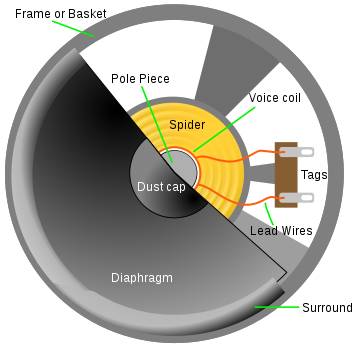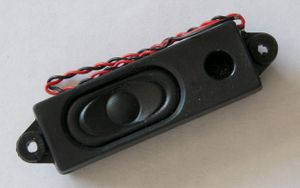Speaker
|
See the Video. |
Summary:
Loudspeakers are electromechanical devices (transducers) which convert electrical signals into sound. Locomotives equipped with sound will employ one or more loudspeakers to reproduce the sound generated by the decoder.
Loudspeakers
Loudspeakers, speakers, or voice coils, are transducers which convert electrical energy into mechanical movement. The mechanical movement of the speaker cone creates the sound that you hear.
The speakers will be mounted either in the body, on the frame or in the fuel tank of a locomotive, or in the tender of a steam locomotive. For proper sound a baffle or enclosure is needed. These can be purchased from a hobby shop or constructed from plastic sheet or stiff cardboard. The baffle enhances both the sound and the volume.
A speaker is constructed by winding light gauge wire into a coil. The coil is then mounted on the speaker cone, and the entire assembly is surrounded by a magnet. When energy flows through the coil, the resulting magnetic field causes the coil to move. The movement creates sound.
The speaker is rated in terms of watts (W) and impedance (Z, indicated in Ohms (Ω)). Watts are the amount of power the coil can withstand, and the impedance is the load the speaker presents to the amplifier driving it. You cannot measure the impedance with a DMM as the coil is almost a short circuit.
Speakers are produced in a variety of sizes, impedances and power capabilities for numerous applications.
Impedance
Impedance is a complex measurement that indicates the resistance, inductance, and capacitance of the voice coil. It cannot be measured with an ohmmeter, as it is an AC only quantity. Impedance is represented by the letter Z. The impedance is mainly from the inductive reactance component of the coil's properties.
Most general-purpose speakers have a nominal impedance[1] [2]of 8Ω (Ohms), such as those used in home audio. For applications such as automobiles, 4 ohms is typical (same volume, less power needed). The value usually is marked on the speaker. You may see the omega symbol Ω, or the letter R used to indicate impedance. [3] The impedance is determined by the design, as a woofer will have a larger gauge wire to handle the power needed for low frequency reproduction, and the tweeters, which don't demand as much energy but must react faster, will be made with a finer wire.
Older ESU multifunction decoders (version 3 or older) used 100Ω speakers. Most multifunction decoders with sound require an 8Ω speaker.
To avoid damaging the amplifier, do not use a speaker of lower impedance than that specified. Higher impedances are acceptable, at the cost of a lower volume output.
Speakers in Series
Speakers wired in series: Total Impedance equals the sum of the individual impedances.
For example, two 8-ohm speakers in series equal 16 ohms total.
Speakers in Parallel
In parallel, 1/Z (total) = 1/Z1 +1/Z2.
or: (Z1 × Z2) ÷ (Z1+ Z2)
- (Remember the Order of Operations)
EXAMPLE: Two 8-ohm speakers in parallel yield a 4-ohm total.
1 ÷ 8 = 0.125 ohms
= 0.125 × 2
= 0.25 ohms
1 ÷ 0.25 = 4 ohms
OR: (8 × 8) ÷ (8 + 8)
= 64 ÷ 16
= 4
Impedance Matching
It is important to match the speakers to the amplifier. For maximum power transfer, they should match. Using a single 16 ohm speaker on an amplifier designed to drive an 8 ohm load will usually result in maximum volume being reduced. The opposite is also true: 4 ohms means more volume with less power.
The real danger is driving a speaker which is too low in impedance. As impedance depends on frequency, and the speaker is really an inductor, the impedance decreases with the frequency. At low frequencies the speaker load could drop to a very low value. The danger is that low frequencies usually mean more power output from the amplifier to drive the speaker, and the lower impedance could overload and damage the amplifier. It could also result in distorted waveforms and damage to the speaker itself.
If installing two 8Ω speakers, wiring them in series reduces the risk of overloading the amplifier. At the same time, sound will be enhanced by the increased speaker cone area. If you can install 4 speakers in a series/parallel arrangement, the effective area of the cone will be increased for better low frequency response.
Speaker Phasing
Phasing means that in an installation with multiple speakers, all speakers move in the same direction. This is accomplished by wiring all connections in the same manner. Speakers usually have a mark at their terminals, so if one speaker is connected with its marked terminal to the marked terminal on the amplifier, the other must be connected in the same manner to its amplifier. In series, the second speaker's marked terminal is connected to the unmarked terminal of the first.
Two terms describe speaker operation: Compression and Rarefaction.
- Compression: the speaker movement compresses the air in front of the cone.
- Rarefaction: The speaker cone moves in the opposite direction, reducing the air pressure in front of the cone.
Incorrect phasing will result in poor sound quality, as one speaker is cancelling out the other (Compression versus Rarefaction.) If wiring two speakers in series, the unmarked terminal on the first speaker connects to the marked terminal on the second one. In parallel, marked to marked. The movement of the speaker cones is in phase, enhancing the sound.
Incorrect phasing attenuates the lower frequencies. It is hard enough to reproduce the low end without phase mismatches.
Other Parameters
When selecting a speaker, there may be a few parameters listed for that specific speaker. The important one is FS (or FO). This value is the resonant frequency in free air. The lower that frequency the better the bass response will be.
For example, a speaker with an FS of 100Hz will produce that frequency with minimal effort. Below that value the output will roll off quickly. It will work well at 150Hz, but not so well at 75Hz.
Another value is the Q factor. This measures the damping, or how closely the speaker will follow the signal, especially at FS. This number is often omitted, lower is the better.
If you want to read more, see: Thiele / Small parameters explained with real world cases
DCC Sound
| Brand | Speaker Impedance (Ohms) | |
|---|---|---|
| Digitrax | 8 – 32 | |
| LokSound | Select | 4 – 8 |
| V3.5 | 100 | |
| V4.0 | 4 – 8 | |
| V5.0 | 4 – 32 | |
| Soundtraxx | LC / DSD | 8 |
| Tsunami | 8 | |
| Tsunami 2 | 8 | |
Speakers for use with DCC should be of the impedance recommended by the decoder manufacturer. Too low an impedance can damage the amplifier, and the speaker. Too high, and the maximum sound levels will be reduced.
For multifunction decoders, speakers will be by necessity, small. This introduces new challenges. The speaker must be mounted securely to avoid resonation with the body shell, with no interference from internal components or wires. For the best reproduction the speaker should be as large as possible, installed with an enclosure, and direct the sound downwards toward the track. Enclosures can be made as needed, purchased, or may even come with the speaker. Many commercial offerings of DCC Sound Equipped locomotives use a number of speakers and enclosures to maximize sound quality and volume.
Videos
NMRAx Clinic on Cellphone Speakers
From the NMRAx convention 24th & 25th March 2020, this video is almost an hour in length.
Items mentioned in the video:
DCC Speaker Principles: Getting the Sound Out (Model Railroad Hobbyist)
MRH DCC columnist Bruce Petrarca provides some amazing insights into how speakers work in a model railroading context, laying the ground work for his Digital Command Control column in the August issue on how to do sound decoder installation in a way that's easy and effective. Part of the content in the August issue of Model Railroad Hobbyist ezine.
See also
External Sites
From HACKADAY:
- ↑ The Nominal Impedance is the lowest point after resonance, rounded to a standard value.
- ↑ https://en.wikipedia.org/wiki/Nominal_impedance#Loudspeakers
- ↑ In print, R is often used. If you see a value like 2R2, the letter (may be R, K, or M) is the multiplier and takes the place of the decimal. 2R2 is 2.2 ohms, and 2k2 is 2200 ohms.




